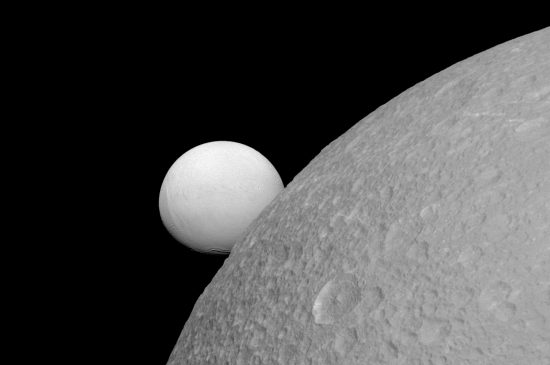
May 28, 2020
This small moon is said to be covered with powdery snow.
The Cassini mission is now over. However, more data continues to be analyzed, particularly those observations of various moons, including Enceladus. Enceladus was named after one of the Gigantes, or Titans, in Greek mythology. Its name might be construed as ironic, since it is a tiny world: 494 kilometers in diameter. Its gravitational acceleration is about 10% of Earth’s 1g field, with a surface temperature of -261 Celsius. Enceladus was discovered by William Herschel in 1789.
On October 28, 2015 the Cassini-Solstice spacecraft flew by Saturn’s moon Enceladus at its closest approach of 49 kilometers, passing over what mission specialists call,“superheated geysers” erupting from the frigid moon’s south pole. Ultraviolet imaging at high resolution detected “icy particles” coming from the vents and plumes.
Recent comparisons in both infrared and ultraviolet frequencies, along with measurements of surface layer thicknesses, determined that the ice particles form a pattern as they fall back onto the moon. According to NASA scientists, such deposits indicate that the plumes are relatively long-lived, perhaps millions of years.
Computer models of plume deposition reveal that ice accumulates on Enceladus very slowly, less than a thousandth of a millimeter per year. Thus, for 100 meters of ice to accumulate, it would take millions of years. Mission team members believe this is important, because it suggests that the heat needed to keep liquid water under the crust would also require long ages of time. Also, without constant replenishment from Enceladus, they speculate that Saturn’s E-ring (formed by plume particles) would dissipate in a mere one hundred years.
Planetary scientists conclude that hot liquid water beneath the surface must be responsible for the plumes, because solar radiation and internal heating are the only energy sources that are allowed in their theories. Solar heating is completely inadequate because the moon is so far away from the Sun, so “tidal kneading” from Saturn might be responsible.
One striking observation is that something similar to what was discovered between Jupiter and its moons (particularly Io) is seen connecting Enceladus with Saturn: an ultraviolet “footprint” in Saturn’s auroral oval. During the August 11, 2008 flyby, Cassini’s plasma sensors found ion and electron beams propagating from Saturn’s northern hemisphere. So, the vapor plumes from Enceladus flow as an electric current to Saturn. Since electricity does not flow in one direction, the one-way connection cannot be correct, so how is the electricity moving between Enceladus and Saturn?
Conventional theories assume that the Universe is electrically neutral, so when observational evidence confirms electrically active plasma for instance, localized phenomena no matter how improbable are invoked. Tidal forces and “cryo-volcanoes” are presented as the cause for the activity seen on Enceladus and the evidence for electric circuits is ignored.
Saturn is connected with the Sun, and the Sun is connected with the Milky Way. The Milky Way is probably connected with the Local Group and then with the Cluster and so on, and so on. That idea is what forms the basis of Electric Universe Theory. An electrical interaction between Saturn and its moons means that they are charged bodies and are not electrically neutral. Saturn exists in a dynamic electrical relationship with the Sun and with its orbiting family.
Stephen Smith
The Thunderbolts Picture of the Day is generously supported by the Mainwaring Archive Foundation.












